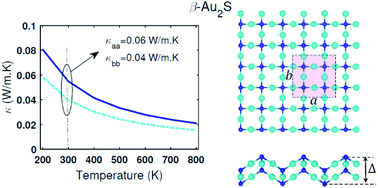Extraordinary lattice thermal conductivity of gold sulfide monolayers†
Abstract
Gold sulfide monolayers (α-, β-Au2S, α-, β-, γ-AuS) have emerged as a new class of two-dimensional (2D) materials with appealing properties such as high thermal and dynamical stability, oxidation resistance, and excellent electron mobility. However, their thermal properties are still unexplored. In this study, based on first-principles calculations and the Peierls–Boltzmann transport equation, we report the lattice thermal conductivity (κ) and related phonon thermal properties of all members of this family. Our results show that gold sulfide monolayers have lattice thermal conductivity spanning almost three orders of magnitude, from 0.04 W m−1 K−1 to 10.62 W m−1 K−1, with different levels of anisotropy. Particularly, our results demonstrate that β-Au2S with ultralow κaa = 0.06 W m−1 K−1 and κbb = 0.04 W m−1 K−1 along the principal in-plane directions, has one of the lowest κ values that have been reported for a 2D material, well below that of PbSe. This extremely low lattice thermal conductivity can be attributed to its flattened phonon branches and low phonon group velocity, high anharmonicity, and short phonon lifetimes. Our results may provide insight into the application of gold sulfide monolayers as thermoelectric materials, and motivate future κ measurements of gold sulfide monolayers.



 Please wait while we load your content...
Please wait while we load your content...